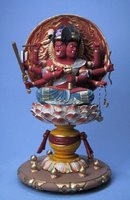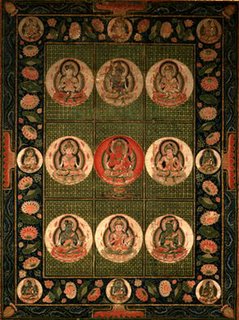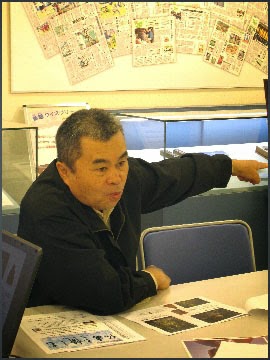LINK
http://fudosama.blogspot.jp/2014/08/tsujimura-jusaburo.html
http://fudosama.blogspot.jp/2014/08/tsujimura-jusaburo.html
:::::::::::::::::::::::::::::::::::::::::::::::::::::::::::::::::::::::::::::::::::::::::::::::::::::::::::::::::::::::::::
Tsujimura Juusaburo 辻村寿三郎 Tsujimura Jusaburo
from the Tsujimura collection 辻村寿和
- quote
2011年制作 Made in 2011
a work made on order.
この作品は、ある方に御注文をいただき制作した作品です。



- source : ameblo.jp/jusaburo

- Take a look at his website :
- source : www.jusaburo.net

.......................................................................
Small dolls make with Jusaburo (1999)

ISBN: 4140310979
- source : www.amazon.com
.......................................................................
- quote
Jusaburo Tsujimura:
Creating Dolls that Reawaken Long Lost Memories

Jusaburo Tsujimura is a doll and puppet maker who works on every aspect of the craft, from facial expressions and costumes to the puppetry itself. He started out making kabuki props, but became interested in puppets after receiving a commission to create some for a television show. Tsujimura has developed his own unique style that combines the traditions of both Japanese and European puppet theater.
- source : www3.nhk.or.jp
.......................................................................
- quote
Dolls Exhibition by TSUJIMURA Jusaburo
TSUJIMURA Jusaburo, born in 1933, is not only a famous artist to make dolls but also an art director of films and theater.

This exhibition will feature about 85 dolls with the theme of Japanese famous ancient novel, Tale of Heike. His new works with images of Buddha and the twelve signs of the Chinese Zodiac will be displayed as well.
- source : www.greentour-kyoto.net/arts
.......................................................................
- quote
Jusaburo Tsujimura is one of most authentic doll artists in Japan. Most of his dolls are traditional Japanese in Kimono, but he also makes some western style dolles. They are so sultry as if they are really alive.
There is "Jusaburo" museum shop in Nihonbashi, Tokyo.
You can learn doll making there as well. If you have any chances to visit Tokyo, it is one of the places worth to take a look at.

By the way, Jusaburo is 80 years old men still very active and energetic ! He was born in 1933. Today one of Japan's finest doll-makers, he actively expands the scope of his art into areas such as costume design, direction, and script writing for stage and film. His performances have received high acclaim including those in America, Europe and Hong Kong.
- source : kimokame.com/kimono-fashions
.......................................................................
- reference : 辻村寿三郎
- reference : tsujimura jusaburo
:::::::::::::::::::::::::::::::::::::::::::::::::::::::::::::::::::::::::::::::::::::::::::::::::::::::::::::::::::::::::::

. - Join Fudo Myo-O on facebook - Fudō Myō-ō .
:::::::::::::::::::::::::::::::::::::::::::::::::::::::::::::::::::::::::::::::::::::::::::::::::::::::::::::::::::::::::::
. Pilgrimages to Fudo Temples 不動明王巡礼
Fudo Myo-O Junrei - Fudo Pilgrims .
[ . BACK to WORLDKIGO . TOP . ]
[ . BACK to DARUMA MUSEUM TOP . ]
:::::::::::::::::::::::::::::::::::::::::::::::::::::::::::::::::::::::::::::::::::::::::::::::::::::::::::::::::::::::::::
Tsujimura Juusaburo 辻村寿三郎 Tsujimura Jusaburo
from the Tsujimura collection 辻村寿和
- quote
2011年制作 Made in 2011
a work made on order.
この作品は、ある方に御注文をいただき制作した作品です。



- source : ameblo.jp/jusaburo

- Take a look at his website :
- source : www.jusaburo.net

.......................................................................
Small dolls make with Jusaburo (1999)

ISBN: 4140310979
- source : www.amazon.com
.......................................................................
- quote
Jusaburo Tsujimura:
Creating Dolls that Reawaken Long Lost Memories

Jusaburo Tsujimura is a doll and puppet maker who works on every aspect of the craft, from facial expressions and costumes to the puppetry itself. He started out making kabuki props, but became interested in puppets after receiving a commission to create some for a television show. Tsujimura has developed his own unique style that combines the traditions of both Japanese and European puppet theater.
- source : www3.nhk.or.jp
.......................................................................
- quote
Dolls Exhibition by TSUJIMURA Jusaburo
TSUJIMURA Jusaburo, born in 1933, is not only a famous artist to make dolls but also an art director of films and theater.

This exhibition will feature about 85 dolls with the theme of Japanese famous ancient novel, Tale of Heike. His new works with images of Buddha and the twelve signs of the Chinese Zodiac will be displayed as well.
- source : www.greentour-kyoto.net/arts
.......................................................................
- quote
Jusaburo Tsujimura is one of most authentic doll artists in Japan. Most of his dolls are traditional Japanese in Kimono, but he also makes some western style dolles. They are so sultry as if they are really alive.
There is "Jusaburo" museum shop in Nihonbashi, Tokyo.
You can learn doll making there as well. If you have any chances to visit Tokyo, it is one of the places worth to take a look at.

By the way, Jusaburo is 80 years old men still very active and energetic ! He was born in 1933. Today one of Japan's finest doll-makers, he actively expands the scope of his art into areas such as costume design, direction, and script writing for stage and film. His performances have received high acclaim including those in America, Europe and Hong Kong.
- source : kimokame.com/kimono-fashions
.......................................................................
- reference : 辻村寿三郎
- reference : tsujimura jusaburo
:::::::::::::::::::::::::::::::::::::::::::::::::::::::::::::::::::::::::::::::::::::::::::::::::::::::::::::::::::::::::::

. - Join Fudo Myo-O on facebook - Fudō Myō-ō .
:::::::::::::::::::::::::::::::::::::::::::::::::::::::::::::::::::::::::::::::::::::::::::::::::::::::::::::::::::::::::::
. Pilgrimages to Fudo Temples 不動明王巡礼
Fudo Myo-O Junrei - Fudo Pilgrims .
[ . BACK to WORLDKIGO . TOP . ]
[ . BACK to DARUMA MUSEUM TOP . ]
:::::::::::::::::::::::::::::::::::::::::::::::::::::::::::::::::::::::::::::::::::::::::::::::::::::::::::::::::::::::::::









































